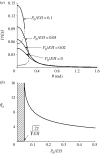Pre-tension generates strongly reversible adhesion of a spatula pad on substrate
- PMID: 18801716
- PMCID: PMC2696141
- DOI: 10.1098/rsif.2008.0322
Pre-tension generates strongly reversible adhesion of a spatula pad on substrate
Abstract
Motivated by recent studies on reversible adhesion mechanisms of geckos and insects, we investigate the effect of pre-tension on the orientation-dependent adhesion strength of an elastic tape adhering on a substrate. Our analysis shows that the pre-tension can significantly increase the peel-off force at small peeling angles while decreasing it at large peeling angles, leading to a strongly reversible adhesion. More interestingly, we find that there exists a critical value of pre-tension beyond which the peel-off force plunges to zero at a force-independent critical peeling angle. We further show that the level of pre-tension required for such force-independent detachment at a critical angle can be induced by simply dragging a spatula pad along a substrate at sufficiently low angles. These results provide a feasible explanation of relevant experimental observations on gecko adhesion and suggest possible strategies to design strongly reversible adhesives via pre-tension.
Figures







References
-
- Chen S.H., Gao H. Non-slipping adhesive contact of an elastic cylinder on stretched substrates. Proc. R. Soc. A. 2006a;462:211–228. doi: 10.1098/rspa.2005.1553. - DOI
Publication types
MeSH terms
LinkOut - more resources
Full Text Sources
Other Literature Sources
